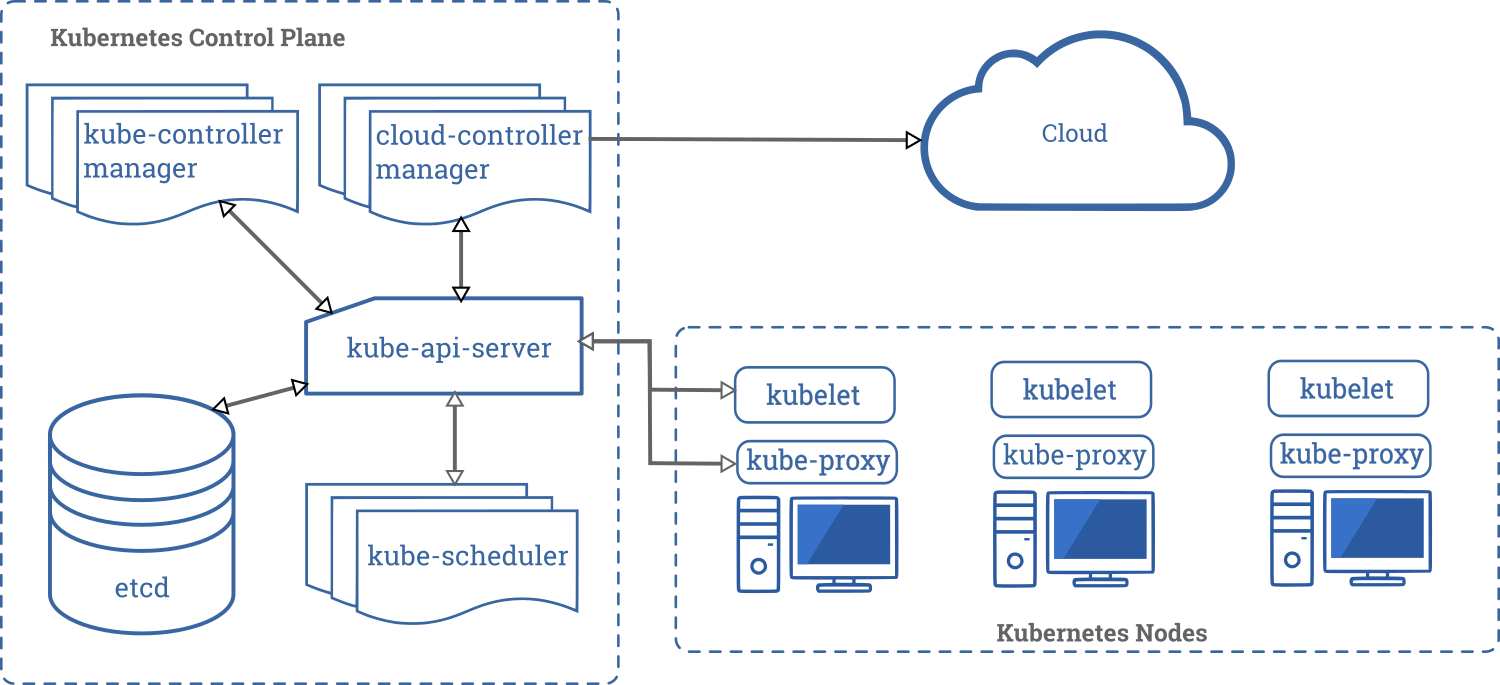Black lives matter.
We stand in solidarity with the Black community.
Racism is unacceptable.
It conflicts with the core values of the Kubernetes project and our community does not tolerate it.
We stand in solidarity with the Black community.
Racism is unacceptable.
It conflicts with the core values of the Kubernetes project and our community does not tolerate it.
Kubernetes v1.11 [beta]
Cloud infrastructure technologies let you run Kubernetes on public, private, and hybrid clouds. Kubernetes believes in automated, API-driven infrastructure without tight coupling between components.
The cloud-controller-manager is a Kubernetes control planeThe container orchestration layer that exposes the API and interfaces to define, deploy, and manage the lifecycle of containers. component that embeds cloud-specific control logic. The cloud controller manager lets you link your cluster into your cloud provider's API, and separates out the components that interact with that cloud platform from components that just interact with your cluster.
By decoupling the interoperability logic between Kubernetes and the underlying cloud infrastructure, the cloud-controller-manager component enables cloud providers to release features at a different pace compared to the main Kubernetes project.
The cloud-controller-manager is structured using a plugin mechanism that allows different cloud providers to integrate their platforms with Kubernetes.

The cloud controller manager runs in the control plane as a replicated set of processes (usually, these are containers in Pods). Each cloud-controller-manager implements multiple controllersA control loop that watches the shared state of the cluster through the apiserver and makes changes attempting to move the current state towards the desired state. in a single process.
Note: You can also run the cloud controller manager as a Kubernetes addonResources that extend the functionality of Kubernetes. rather than as part of the control plane.
The controllers inside the cloud controller manager include:
The node controller is responsible for creating NodeA node is a worker machine in Kubernetes. objects when new servers are created in your cloud infrastructure. The node controller obtains information about the hosts running inside your tenancy with the cloud provider. The node controller performs the following functions:
Some cloud provider implementations split this into a node controller and a separate node lifecycle controller.
The route controller is responsible for configuring routes in the cloud appropriately so that containers on different nodes in your Kubernetes cluster can communicate with each other.
Depending on the cloud provider, the route controller might also allocate blocks of IP addresses for the Pod network.
ServicesA way to expose an application running on a set of Pods as a network service. integrate with cloud infrastructure components such as managed load balancers, IP addresses, network packet filtering, and target health checking. The service controller interacts with your cloud provider's APIs to set up load balancers and other infrastructure components when you declare a Service resource that requires them.
This section breaks down the access that the cloud controller managers requires on various API objects, in order to perform its operations.
The Node controller only works with Node objects. It requires full access to read and modify Node objects.
v1/Node:
The route controller listens to Node object creation and configures routes appropriately. It requires Get access to Node objects.
v1/Node:
The service controller listens to Service object Create, Update and Delete events and then configures Endpoints for those Services appropriately.
To access Services, it requires List, and Watch access. To update Services, it requires Patch and Update access.
To set up Endpoints resources for the Services, it requires access to Create, List, Get, Watch, and Update.
v1/Service:
The implementation of the core of the cloud controller manager requires access to create Event objects, and to ensure secure operation, it requires access to create ServiceAccounts.
v1/Event:
v1/ServiceAccount:
The RBACManages authorization decisions, allowing admins to dynamically configure access policies through the Kubernetes API. ClusterRole for the cloud controller manager looks like:
apiVersion: rbac.authorization.k8s.io/v1
kind: ClusterRole
metadata:
name: cloud-controller-manager
rules:
- apiGroups:
- ""
resources:
- events
verbs:
- create
- patch
- update
- apiGroups:
- ""
resources:
- nodes
verbs:
- '*'
- apiGroups:
- ""
resources:
- nodes/status
verbs:
- patch
- apiGroups:
- ""
resources:
- services
verbs:
- list
- patch
- update
- watch
- apiGroups:
- ""
resources:
- serviceaccounts
verbs:
- create
- apiGroups:
- ""
resources:
- persistentvolumes
verbs:
- get
- list
- update
- watch
- apiGroups:
- ""
resources:
- endpoints
verbs:
- create
- get
- list
- watch
- update
Cloud Controller Manager Administration has instructions on running and managing the cloud controller manager.
Want to know how to implement your own cloud controller manager, or extend an existing project?
The cloud controller manager uses Go interfaces to allow implementations from any cloud to be plugged in. Specifically, it uses the CloudProvider interface defined in cloud.go from kubernetes/cloud-provider.
The implementation of the shared controllers highlighted in this document (Node, Route, and Service), and some scaffolding along with the shared cloudprovider interface, is part of the Kubernetes core. Implementations specific to cloud providers are outside the core of Kubernetes and implement the CloudProvider interface.
For more information about developing plugins, see Developing Cloud Controller Manager.